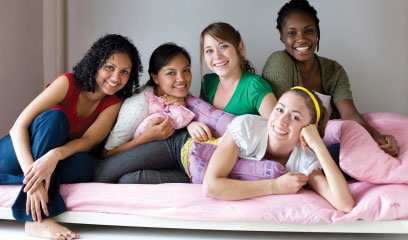
The latest video games . . . unlimited potato chips . . . and a flat-screen TV packed with hundreds of channels — all that you need to create a fabulous teen-friendly environment — right? Those things don’t hurt, sure, but experts say there’s one thing that’s even more attractive to teens: cool (but not pushover!) parents.
Making teens feel welcome
“Teens want a place where they can put their feet up; literally and metaphorically,” explains Seattle parenting coach Margit Crane. “Teens like authentic, warm adults. They seem to have built-in lie detectors that can sense when a parent may not like them or when someone is not being genuine.”
Kingston mother Kelli Agodon agrees. “When our daughter brings a friend over, we try to make them feel at home,” she says. “We don’t censor any conversations, and I think they appreciate the openness. I know all of her friends very well, so I know what they each like or need when they’re here. A few are always hungry, so we always have snacks to share. Two love to draw and do art, so there are always supplies for them.”
Port Townsend high school senior Nicole agrees that open communication with her friends’ parents is one of the biggest draws in deciding where she spends her free time. “My friend’s mother feels less like a parental figure and more like an additional friend, because she shares a similar sense of humor as my friend. The conversation always flows easily and stays light.”
Nicole has also felt very unwelcome at friends’ houses: “One of my friend’s parents does not tolerate ‘excess noise,’ which is difficult when a group of teenagers gather in one setting,” she says. “Many of the rooms in the house are off limits, and her younger sister occupies the only room we can go to. We avoid going there unless it is our last resort.”
Ron Feinberg, M.S.W., a Mercer Island therapist, encourages parents to make themselves teen-friendly and to give some thought to how they talk to, listen to and treat their teen and the teen’s friends. “Parents can be both a friend and a parent,” within reason, Feinberg says.
Make it work for the family
If your home has an additional room or basement that can be used as a family area, include your tween or teen in the planning process. A family room presents a perfect place for teens to have their own space, yet remain within earshot of nearby adults. Plus, decorating the room in a way that will suit everyone’s needs can be a great way to connect with your teen on their interests, and for you to show them that you trust and respect their decisions.
When planning her own family room, Agodon says, she tried to keep it simple. “We have a very pet- and teenager-friendly home; if something spills on the hardwood floors, we just clean it up, and it’s not an issue. We also have furniture that we can clean up easily.”
Having your teen help plan a family room may have the added advantage of giving him a feeling of investment in the space, which could result in greater care and cleaning. “Relationships are reciprocal,” says Feinberg. “Children who feel respect return that respect and trust.” Planning the family room with your teen can also provide an excellent opportunity for discussing ground rules and your expectations about how the room will be used.
Crane offers four basic ground rules for parents to consider discussing with their teen: Don’t destroy property; clean up after yourself; keep language clean; and no physical or emotional abuse will be tolerated in the space.
Privacy: how much?
Both Crane and Feinberg agree that privacy should be handled on a case-by-case basis. “Get to know your kid, inquire. Dialogue to find appropriate boundaries,” Feinberg says. “If you recognize a child’s confidences, they will rise to the occasion, and if a teen is given the privacy that they’ve earned, they deserve it.”
Agodon relies on her instincts when deciding how much privacy is appropriate or needed. “If a friend comes over who I know likes to surf the Internet or get into things that they shouldn’t be getting into, it’s probably not a good idea to allow the laptop in the bedroom with the door closed. However, some kids may only want to use the laptop for music, or to draw on the computer. It all depends on the kids and your level of trust with them.”
Your relationship is key
Parents and experts agree that having your teen and their friends in your home can be a great experience — and one that might not last long.
“I remind myself that this is a temporary situation and not to make a big deal about how loud they can be,” says Agodon. “It’s easy to forget that we were once noisy teenagers. I try to remember that they’re just girls being girls and to allow them to enjoy themselves . . . even if I’m not excited to hear the Lady Gaga parody song one more time.”
And what makes a home most inviting to a teen and their friends? “Teens don’t need cool parents, but cool parents can be nice, too,” Crane suggests. “What’s most attractive is a healthy home where people have civil and sane interactions, and resolve conflicts easily. That’s a safe home,” she says.
“Then there’s the food!”
Jen Betterley is ParentMap’s web editor and she frequently writes articles for various Seattle publications.











